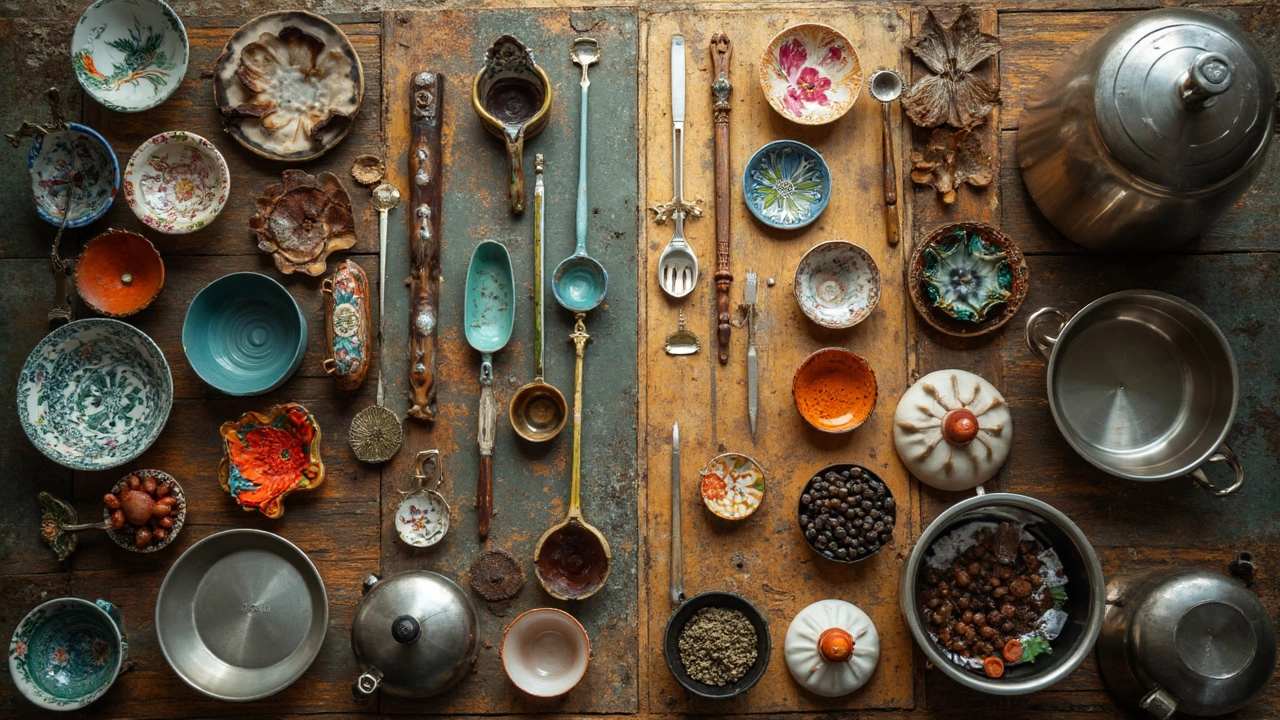Ever stood in your kitchen, looking at a pile of spoons, pots, and gadgets, and thought, 'What's really the difference between utensils and kitchenware?' Well, you're not alone, and we're here to clear things up. Simply put, utensils are generally tools you use directly with food—like your trusted spatula or favorite ladle. On the other hand, kitchenware tends to cover a broader range, including items like pots, pans, and baking trays. Understanding this basic difference can really help streamline your kitchen experience.
Now, why does this matter? Knowing what falls into each category helps you make smarter choices when stocking your kitchen or when you're on that shopping spree to upgrade your cooking game. Utensils, being more hands-on, often need cleaning up right after cooking, while kitchenware such as your pots may sit around holding leftovers. Little distinctions like these can impact how you organize and maintain your kitchen space.
Definitions and Distinctions
When it comes to understanding what makes utensils different from kitchenware, it helps to start with what each term actually means. Utensils refer to handheld implements used in the kitchen for preparing and serving food. We're talking anything from your everyday spatula, tongs, to the humble whisk. Basically, if you're using it to stir, flip, or pick up food, it's a utensil.
Kitchenware, on the other hand, is a bit more inclusive. This term covers the larger collection of tools and containers in the kitchen that aren't necessarily used directly with food by hand. Think pots, pans, baking dishes, and even storage containers. In essence, kitchenware can be seen as the backbone of the cooking space—you can't really make a meal with just utensils alone!
Why It Matters
So, why should you care about these definitions? Firstly, it streamlines your cooking process. Knowing what qualifies as a kitchen utensil versus kitchenware helps you quickly locate exactly what you need when you're in the middle of a cooking frenzy. No more rummaging through drawers when all you need is simply a potato masher!
Plus, understanding these categories also aids in maintenance. Utensils often require careful washing and can be easily misplaced. Kitchenware items, like those heavy-duty pans, may need more than just a rinse to maintain their longevity and efficiency.
| Category | Examples | Primary Use |
|---|---|---|
| Utensils | Spatula, Ladle, Tongs | Direct food handling |
| Kitchenware | Pan, Baking Dish, Storage Container | Cooking, baking, storing |
Common Examples
Identifying what's what in your kitchen doesn't have to be rocket science. Let's break down some common examples, so you know exactly where your gear fits in.
Utensils: Everyday Helpers
Your trusty spatula, the ladle you can't live without, and even your collection of knives—all these fall under utensils. These are the tools you use directly with food, whether it’s flipping pancakes or tossing salad. You can think of these items as the hands-on gear in your kitchen.
Kitchenware: The Bigger Picture
When we say kitchenware, think broader. This includes your non-stick frying pans, stainless steel pots, and even the trusty Dutch oven. Basically, anything that’s used to cook or prepare food that doesn't involve direct hand-to-food interaction. You'll also include baking essentials here, like baking sheets and muffin tins.
Household Must-Haves
- Utensils: Tongs, peelers, and whisks.
- Kitchenware: Mixers, toasters, pressure cookers.
Another good way to remember the difference is that utensils are usually stored in drawers, while kitchenware often finds its place in cupboards or on the counter for easy access.

Materials and Uses
Let's chat about kitchenware and utensils—from materials they're made of to how they're used. It really comes down to matching the right gear with the right task. When it comes to materials, you'll find kitchenware made of stainless steel, cast iron, aluminum, copper, and non-stick surfaces, each with its perks and quirks.
Stainless Steel
Your trusty stainless steel pans are a solid choice for durability. They're pretty much a staple in any kitchen. You get even heating and they're kind of indestructible, especially when it comes to scratching and maintaining appearance. They're also often dishwasher safe, which is a definite plus for busy households.
Cast Iron
Cast iron is the heavy-duty option, literally. It's fantastic for heat retention and fantastic for dishes that need a bit of sear—like your classic steak. But heads up, they do require seasoning to maintain that non-stick feature. So if you go this route, don't forget to give them some love now and then.
Non-Stick Surfaces
Non-stick cookware is amazing for those mornings when you're making pancakes. The coating makes cleaning up a breeze, but you want to avoid metal utensils with these guys to keep them in top shape. Opt for silicone or wood instead to prolong their life.
Aluminum & Copper
Aluminum is affordable and light, handy for fast heating. Copper, on the other hand, is all about precision cooking; it has that wow-factor if you're serious about your crepes or sauces. Though, note that copper tends to be pricey and usually needs a bit more TLC for longevity.
By choosing the right material for your tasks, you can elevate your cooking. This is where knowing your kitchenware from your utensils truly pays off. Imagine trying to flip an egg with a cast iron pan—tricky, right? With the right tools, you can sear, sauté, and serve up delicious meals with less hassle and more flair.
Practical Tips
So you’ve got your kitchenware and utensils all sorted out, but how do you make the most out of them? Here are some practical tips to keep your kitchen efficient and your cooking enjoyable.
1. Group Your Gear
It's a game-changer to organize your utensils and kitchenware in a way that makes sense for your cooking style. Keep the spatulas, ladles, and other frequently used utensils in a container on your countertop for easy access. Store your pots and pans together, ideally near the stove, so you’re not running around when the heat is on!
2. Material Matters
Let's talk about choosing materials. Non-stick pans are lifesavers for easy cleanup, but they require using wooden or silicone utensils to avoid scratches. Stainless steel utensils are sturdy and long-lasting but not always ideal for non-stick surfaces. Get a mix that caters to different cooking methods and maintains your cookware longevity.
3. Do a Regular Check-Up
A regular inventory check can help spot worn-out kitchenware before it becomes a kitchen hazard. Inspect handles, ensure non-stick coatings aren't peeling, and replace anything that’s seen better days. Investing in good-quality replacements saves money and hassle in the long run.
4. Energy Efficiency
| Cookware Type | Average Cooking Time Reduction |
|---|---|
| Induction-compatible pans | 30% |
| Copper cookware | 25% |
Believe it or not, the type of cookware you use can make a massive difference in cooking time. For instance, Kitchenware that's induction-compatible heats faster than traditional ones, cutting down the time you spend in the kitchen. Copper pots and pans are also known for excellent heat conduction. This not only speeds up meal prep but also helps conserve energy.
5. Embrace Multi-Taskers
Find items that can do double duty. A cast iron skillet, for example, can go from stovetop to oven, saving on cleanup and storage space. Investing in versatile kitchenware means fewer items cluttering up your shelves while still giving you endless cooking options.



